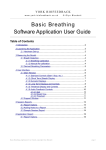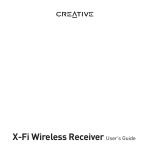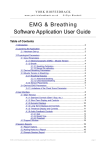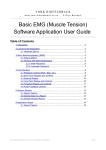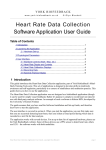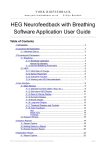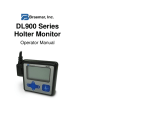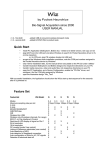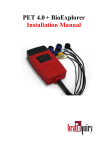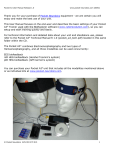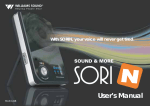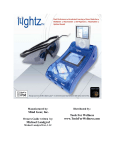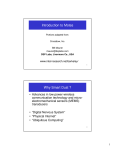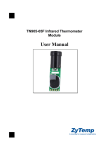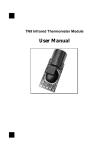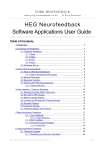Download Pocket Neurobics Pendant® AAA - Bio
Transcript
Pendant® Pod User Manual Rel 3.6 Pocket Neurobics Wireless Pendant® AAA Pods Technical & User Manual ‐ Pendant® EEG ‐ Pendant® pIR HEG 1 © 2008 Pocket Neurobics Pendant® Pod User Manual Rel 3.6 Pocket Neurobics • • • • • • • • • • Release 1.1 12 May 04, Program/Pod/Standalone modes Release 2.0 17 July 04, simplification to two modes only: Operating and Program Release 2.1 10 August 04, added BoExplorer & BioEra support for quickly changing Pendant® profile, sampling rate vs link resilience to errors. Release 3.0 26 October 04, includes Pendant® HEG, both nIR & pIR system Release 3.1 29 November 04, adds tables of rf channel assignment Release 3.2 5 March 05, ed. to Connections Release 3.3 6 July 2005 general revision, new images Release 3.4 30 July 2007 eeg electrode info Release 3.5 26 February 2008 new AAA Pendant® EEG & pIR info Release 3.6 19 June 2008 AAA Pendant pIR calibration described IMPORTANT NOTICE: Minder Labs PL MAKES NO WARRANTIES, EXPRESS OR IMPLIED, INCLUDING, BUT NOT LIMITED TO, ANY IMPLIED WARRANTY OF MERCHANTABILITY OR FITNESS FOR A PARTICULAR PURPOSE, beyond product defect warranties expressly given in the body of this document. The User is responsible for determining whether this product is fit for a particular purpose. IMPORTANT NOTICE: This product is NOT FOR MEDICAL USE and is solely for PERSONAL USE. Not for use by children. Not for use by photosensitive epileptics. The prospective user is advised that some individuals with sensitive nervous systems may have negative reactions to neurofeedback and/or light & sound training. This can be the case even under professional guidance. Reports of negative reactions are rare & mostly anecdotal. If headaches or discomfort arise, cease use. Prior to use, READ USER MANUAL in its entirety, particularly the Section on USER SAFETY. 2 © 2008 Pocket Neurobics Pendant® Pod User Manual Rel 3.6 Pocket Neurobics Contents QUICK START 4 INTRODUCTION 4 USER SAFETY 5 CONDUCTION OF ELECTRICITY THROUGH EEG ELECTRODES ....................................................................................................................................... 5 INFECTION RISK (PENDANT® EEG) ....................................................................................................................................................................... 5 PRODUCT CARE & MAINTENANCE 5 SYSTEM RESET ............................................................................................................................... ................................................................... 5 RECHARGEABLE BATTERY .................................................................................................................................................................................... 5 WARRANTY ..................................................................................................................................................................................................... 6 PACKING LIST 6 CONNECTIONS 6 POWER UP 7 PUSHBUTTON FUNCTION 7 RF CHANNEL CHANGE ............................................................................................................................... ......................................................... 8 MODE CHANGE ................................................................................................................................................................................................ 7 SIGNAL VALIDITY ................................................................................................................................................. ERROR! BOOKMARK NOT DEFINED. MANAGING THE WIRELESS LINK & FAULT FINDING 9 INTEFERING SIGNALS ............................................................................................................................... ........................................................... 9 NO CONNECTION .............................................................................................................................................................................................. 9 BATTERY MANAGEMENT 9 APPENDIX 1: PROCEDURE TO PLACE ELECTRODES AND THE 10‐20 SYSTEM ................................................................................................................ 10 3 © 2008 Pocket Neurobics Pendant® Pod User Manual Rel 3.6 Pocket Neurobics Quick Start The Pendant® Pod system acquires a bio‐signal and sends it over a wireless link to a PC application for processing and feedback. The system comprises the Pendant® wireless pod with rechargeable battery, a USB port wireless dongle, and a USB port battery charger. The system can operate on any one of eight wireless channels ‐ the Pendant® Pod and the dongle need to be set to the same wireless channel. If not supplied with the product, electrodes for the Pendant® EEG can be ordered from http://www.pocket‐ neurobics.com or alternatively standard 1.5mm electrodes (do not use gold electrodes) can be obtained on‐line from.. • http://www.telegrass.com or • http://www.rochestermed.com The electrode kit supplied by Pocket Neurobics includes scalp and earclip electrodes sufficient to implement any one or two channel protocol. Before first use: • Charge the battery overnight on the battery charger which plugs into a USB port. It is a good idea to place the battery on the USB charger whenever the Pendant® is not in use. If there is a shortage of USB ports, then a low cost USB expansion hub, which typically provides three extra USB ports, can be used. • Install the Windows drivers supplied for the Wireless Dongle. Refer to Install Manual for detailed information. • If BioExplorer software has been purchased, refer to Install Manual for more information. Introduction This User Manual describes the variants of the wireless Pendant®® Pod system: • the Pendant® EEG, a 2 channel EEG • the Pendant® pIR HEG (passive Infrared) [HEG systems measure brain blood flow oxygenation levels. The HEG systems require a special headset sensor.] All systems are ‘pods’, meaning that their purpose is to acquire a biofeedback signal for processing by separate PC‐based Biofeedback Applications. The Pendant® supports two or modes of operation: • Operating Mode (green light): acquires raw bio‐signals and passes this data to PC‐based Biofeedback software via a USB‐wireless dongle. In the case of the Pendant® EEG, the Pod allows a choice in sampling rates of 122/128/256/512 samples per second (sps) and a choice in eeg bio‐ signal bandwidth of 40Hz or 48Hz (and 56Hz for special applications). For the Pendant® HEG pIR, the sampling rate as seen at the PC application is fixed at 256sps. • Programming Mode (red light): this mode is selected to allow programming of the Pendant®, either to upgrade the firmware of the Pendant®, or to change the Pendant® profile: eg in the case of the Pendant® EEG, its sampling rate and eeg signal bandwidth • Calibration Mode (yellow light): this mode allows fine calibration of the temperature reading. 4 © 2008 Pocket Neurobics Pendant® Pod User Manual Rel 3.6 Pocket Neurobics The Pendant® Pod currently supports the following Biofeedback Applications: • BioExplorer – http://www.cyberevolution.com supports quick Pendant® profile change, version upgrades, & checking of current version • BioEra – http://www.proatech.com/products/bioerapro/ supports quick Pendant® profile change, version upgrades, & checking of current version • EEGer – http://www.eeger.com/ supports the Pendant® EEG at the default sampling rate of 256 sps • Pocket Neurobics Firmware Loader – http://www.pocket‐neurobics.com/upgrade.htm supports version upgrade (this is not a biofeedback application, merely a file load utility) The Pendant® EEG frequency response is 1.6Hz to 40/48/56Hz with extension down to 0.1Hz at a lower gain setting. This allows the use of the Pendant® EEG for Slow Cortical Potential (SCP) and Electrocardiogram (ECG) applications. User Safety Conduction of Electricity through EEG Electrodes To operate, EEG systems require a low resistance path to the scalp. Should these paths come into contact with lethal voltages, serious injuries or death could result. Safety is thus an imperative and Pocket‐Neurobics.com have adopted best practice in this area of design: • battery operation • wireless external links to remove the possibility of PC failure & dangerous voltages conducted via wires • EEG currents between the unit and the user are strictly limited in accordance with international standard IEC601 ENSURE THAT THE UNIT IS OPERATED IN SAFE RESIDENTIAL OR OFFICE ENVIRONMENTS – DO NOT USE IN INDUSTRIAL OR HOSPITAL ENVIRONMENTS. CONNECT EEG CABLE TO PENDANT® EEG UNIT ONLY – DO NOT CONNECT TO ANY OTHER DEVICE OR CONNECTOR. Infection Risk (Pendant® EEG) Traditional approaches to the placement of EEG electrodes on the scalp involve abrading the skin to reduce electrode‐ scalp impedance (less than 5K ohms is traditionally recommended). Breaking the skin creates the risk of infection from blood‐borne pathogens such as HIV, Hepatitis‐C, and Creutzfeldt‐Jakob disease. Although there have been no reported cases of such infections resulting from EEG sessions, the U.S. Centre for Disease Control has issued guidelines recommending that electrodes be sterilised prior to re‐use. With modern instrumentation amplifiers as used in the Pendant® EEG, an electrode‐scalp impedance of less than 5K ohms is not necessary. Values less than 40K ohms are quite serviceable. It is therefore recommended that skin not be abraded. Both cup electrode and saline‐solution electrodes can perform satisfactorily without abrasive skin preparation. When using conductive electrode paste & metallic cup electrodes, the recommended procedure is to first rub conductive paste on the site, then add more paste to the site for bulk, and then apply the electrode (filled to excess with paste). Product Care & Maintenance System Reset The Pendant® Pods can be reset by turning off the device via the switch at the base of the unit. Rechargeable Battery Two AAA NiMH rechargeable batteries are supplied with the unit. The unit can operate continuously for up to 8 hours after overnight recharge. If the Pendant® Pod is used only irregularly, please remove the battery from the unit prior to storage. Shelf‐life for a fully charged battery is a few weeks. The battery should be good for at least 300 charge cycles. 5 © 2008 Pocket Neurobics Pendant® Pod User Manual Rel 3.6 Pocket Neurobics Warranty The Pendant® Pods are warranted against electrical failure for 30 days from date of purchase (see exceptions below). If, within this 30 day period, the unit ceases to function with it not having experienced physical damage to the case, it, together with its wireless dongle (do NOT return electrodes, headsets or charger), may be returned to the factory for free repair or replacement. For details on shipping, please email support@Pocket‐Neurobics.com.: Shipping costs to the factory are the responsibility of the user (typically about US$40). Pocket Neurobics shall repair or replace the unit and pay for return shipment. The unit is not warranted against abuse, nor against • failure of the battery • corrosion or contamination of EEG electrodes (electrodes are considered a consumable) Replacement battery units can be obtained from local electronics stores such as Tandy. Replacement electrodes can be ordered from Rochestermed.com, TeleGrass.com or other sources. (See Pocket‐Neurobics home page for details.) For units which fail whilst out of warranty, and not having suffered physical damage, a service fee of US$120 for repair or replacement shall be applicable. Packing List Pendant® EEG w. touch‐proof electrode interface (electrodes not supplied) or Pendant® HEG pIR (headset normally included) 2 AAA rechargeable batteries USB‐wireless dongle USB NiMH battery charger Retractable USB extension Cable Install Manual CD including • this user manual • Windows drivers for the Wireless Dongle • Copy of BioExplorer (requires USB security dongle) • Sample BioExplorer designs • Sample BioExplorer video files • Updates and General Information 9 9 9 9 9 9 9 Connections The Pendant® EEG interfaces to standard 1.5mm touchproof electrodes. The unit provides two bipolar montage EEG circuits and a Neutral electrode ‐ a total of five EEG electrodes. Red terminals indicate the “+” electrode and black terminals indicate the “‐“ electrode. The outermost red terminal identifies EEG Channel 1. The green terminal is the Neutral electrode. It is a “driven right leg” circuit and works actively to suppress 50/60Hz interference. If operating just one eeg channel, choose EEG Channel 1. The Pendant® HEGs connect directly to the respective headset. The wireless link connects to a USB wireless dongle which can be connected directly into a USB port or, to improve link resilience, attached to the monitor with the velcro supplied in accordance with the images. 6 © 2008 Pocket Neurobics Pendant® Pod User Manual Rel 3.6 Pocket Neurobics There is an on/off switch at the base of the unit, and there is a push‐button switch on the side of the unit. The switch on the side of the unit controls the setting of Operating/Programming mode, and the setting of the wireless channel number. For all Pendant® Pods, there are two channels of data sent to the PC over the wireless link. These two channels are assigned as follows: Device RF Link Channel 1 RF Link Channel 2 Pendant® EEG EEG Channel 1 EEG Channel 2 Pendant® HEG pIR HEG Channel 1 Battery Voltage readout Power Up The Pendant® Pods are switched on and off by a small switch on the base of the unit. Pushbutton Functions The Pendant® Pods have three (03) push buttons on the side of the unit as follows: Changes mode after 4 seconds V+ Changes channels up v‐ Changes channels down All buttons are activated by pressure. The green LED indicates Operating Mode and the red LED indicates Programming Mode. In either mode, the wireless channel number is indicated by the number of flashes (one flash indicates Wireless channel 01 is active, eight flashes indicate Wireless channel 08 is active). The V+ and V‐ channel change buttons are only active in Programming Mode. Mode change Pressing the button for greater than four seconds will toggle between modes: Operating Mode (green LED): acquires raw bio‐signals and passes this data to PC‐based Biofeedback software via a USB‐ wireless dongle. The Pendant® EEG is shipped with 256sps/40Hz as the default profile, however other profiles (ie other sampling rates and bandwidths) can be selected if this function is supported by the Biofeedback Application. To reprogram the Pendant®, it first must be placed on Programming Mode (red LED). For the Pendant pIR pressing the mode button again will change to Calibration mode. Note that the Pendant® Pod passes advice on the current sampling rate to the Biofeedback Application, and the Biofeedback Application will automatically switch to the correct sampling rate. Programming Mode (red LED): this mode is selected to allow changing Profiles: ie changing the sampling rate or EEG signal bandwidth, or a general upgrade of the Pendant® Pod’s firmware as new features are introduced. 7 © 2008 Pocket Neurobics Pendant® Pod User Manual Rel 3.6 Pocket Neurobics Wireless channel change It may be required to change the wireless channel number for one of two reasons: • there is interference from sources such as wireless LANs, or Bluetooth devices • there is more than one Pendant® device within a range of 10 metres Both the Pendant® and the Wireless Dongle need to be set to the same wireless channel. The Wireless Dongle uses the following mechanism to manually change the wireless channel: In Programming Mode, activating the V+ or V‐ pushbutton will select one of the eight available wireless channels. Pressing V+ will increment the wireless channel number by one and pressing V‐ will decrement the channel number by one. The LED will flash according to the wireless channel selected (a single flash for rf ch1, etc). Whilst the Wireless Dongle is receiving a valid signal from a Pendant® Pod, the green LED on the Dongle will be steady on, and the wireless channel number will flash off. When the Dongle is not receiving a signal, the LED will be steady off, and the wireless channel number will flash on. Similarly, when the Pendant® is in Operating mode, it’s LED will be steady on, indicating that it is transmitting, and will flash off the wireless channel number, whereas in Programming mode, it’s LED will be off and the wireless channel number will flash on. Note that the Biofeedback Application software may allow the user to change the RF Channel number of the Wireless dongle. Firmware version and serial number To identify the version of the firmware on your unit, the Biofeedback Application may have a tool specific to the Pendant® Pod labelled “About”. The Pendant® needs to be in Programming mode to activate this function. The serial number and version of the firmware of the Wireless Dongle and other devices that the dongle may have “discovered”, such as a Pod, are reported to the Biofeedback Application. Version numbers appear similar to: • “Dgl20x” – wireless dongle version 20x • “e0‐20x” ‐ Pendant® EEG version 20x • “h1‐20x” – Pendant® HEG pIR version 20x The About function will also identify a serial number such as: • “sn12345678” Calibrating the Pendant pIR Pressing the Mode button again changes the mode from Programming Mode (red LED) to Calibration Mode (yellow LED). In Calibration mode the wireless channel change buttons described above can be used to increment or decrement the nominal temperature readout +‐5degC at body temperature. This is generally a one‐time operation since the Pendant will remember the last setting. There are 16 increments between ‐5deg and +5deg meaning accuracy of +‐ 0.6degC can be achieved. The nominal value (ie no calibration) can be restored by observing the oscilloscope trace whilst pressing the calibration buttons and counting eight steps from either the maximum or minimum excursion. Signal Validity The Pendant® Pods transmit information to the Biofeedback Application regarding the validity of the raw biofeedback data. This information will typically appear in the Status Bar of the Biofeedback Application: • Pendant® EEG: the magnitude of the EEG signal. Where the EEG signal is excessive, perhaps due to a poorly contacting electrode, the signal will be flagged as invalid. • Pendant® HEG pIR: thermocouple sensor not connected. 8 © 2008 Pocket Neurobics Pendant® Pod User Manual Rel 3.6 Pocket Neurobics Managing the wireless link & Fault Finding Interfering signals The 2.4Ghz band is shared with Bluetooth, some wireless LANs, microwave ovens, and some video and sound surveillance systems. To help prevent interference, and to allow multiple devices to operate in close proximity, eight wireless channels are provided. So, in the presence of an interfering signal, which will be evidenced by synchronisation errors being reported by the Biofeedback Application, first recourse is to try a different wireless channel. If this is not successful, note that signals at these frequencies do not pass thru objects, but rather will bounce off walls etc. Thus, isolating systems thru partitions etc will generally be effective. A USB extension cable can be used to either improve the line‐of‐sight between the Pendant® and the Wireless Dongle (for instance by velcroing the wireless dongle in an elevated position), or by hiding the Wireless Dongle away from interfering signals. Maximum range (~5m), is best assured by elevating the dongle. Also note that the resilience to wireless link errors will be significantly improved by reducing the sampling rate of the Pendant® EEG (ie changing the Pendant® EEG Profile). Reducing the sampling rate from 512sps to 256sps or from 256sps to 122/128sps, will improve resilience to errors. No Connection If the Biofeedback application is not synchronised to the incoming signal, check the following: • Is there more than one Pendant® Pod in the vicinity? If so, are they transmitting on the same wireless channel? • Is the Green light on the Wireless Dongle flashing? If not, the Wireless Dongle is faulty • Is the Green light on the Wireless Dongle mostly on? If not, then the problem rests with the Pendant®. Is the Pendant® in Operating mode (i.e. is it’s light Green)? Is the Pendant® on the same wireless channel as the Wireless Dongle? • If the Green light on the Wireless Dongle is mostly on, then the problem lies with the PC or Biofeedback Application. Has the Biofeedback Application selected the correct virtual COM port, and is the Parity for this port set to “none”? Has the Biofeedback Application activated the virtual COM port? • Does the ‘design’ for your Biofeedback Application specifically select the Pendant® Pod, or has it selected another acquisition device? Battery Management A low battery condition is advised to the Biofeedback Application over the wireless link.. This information is usually presented in the Application's Status Bar. Recharging the battery overnight should give continuous operation for about 8 hours. It is therefore good practice to leave the battery on charge each evening – note that the battery can be left on charge indefinitely. 9 © 2008 Pocket Neurobics Pendant® Pod User Manual Rel 3.6 Pocket Neurobics Appendix 1: Procedure to place Electrodes and the 10‐20 system To measure a brainwave signal, the electrodes can either be in pairs, with the difference in voltage between the two electrodes captured (this is called bipolar mode), or there can be a common probe to which all other (unpaired) electrodes are referenced. This is called referential or monopolar mode. The bipolar mode has the advantage of being able to measure the differences between various parts of the brain, whilst the referential mode allows multiple signals whilst minimising the number of electrodes. Both modes are in common usage. Note that the reference probe can be attached to the body anywhere, however most commonly it is attached to the ear on the side of the brain being studied. If both hemispheres are being exercised, the reference probe can be attached to either ear or to both (using a “linked‐ear” cable), or along the mid‐line of the brain. It is also required to attach a neutral connector to the user to ensure that the user and the eeg machine are of equal potential. This is done in such a way so as to ensure only minute currents flow between the user and the instrument. The neutral electrode is usually an earclip. The 10‐20 system describes the locations on the scalp as shown below. The symbols F, C, P, O, and T are short hand for the major lobes of the brain: frontal, central, parietal, occipital and temporal respectively, whereas the numeric subscripts describe a location on the lobe, with odd numbers on the left hemisphere and even numbers on the right. Note that a subscript of "z" denotes the midline point. For a single active probe (ie 1 channel referential montage) a commonly used point for the active electrode is either C3, C4 or Cz with the reference on one or both ears. For two active electrodes the most common points are C3 and C4, with a reference at the ears or on the mid‐line. In a clinical environment it would be common for the electrodes to be relocated from time to time during a session, with specific regimens to treat specific conditions. 10 © 2008 Pocket Neurobics










